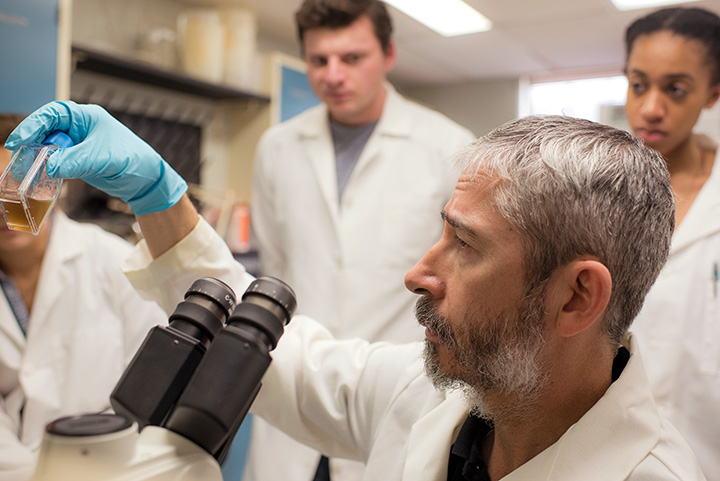| |
|
|

Mario J.
Grijalva, Ph.D.
|
|
|
|
 |
| |
|
| |
|
|
Research Overview:
|
|
|
|
|
|
My laboratory investigates how infectious diseases emerge, persist, and can be controlled in vulnerable communities in Latin America and in Appalachian Ohio. We combine molecular epidemiology, field ecology, diagnostics development, and health communication to better understand pathogens and translate that knowledge into practical tools for prevention and control.
|
|
|
|
|
|
Our work is based at Ohio University in Athens, Ohio, and at the Center for Research on Health in Latin America (CISeAL) at the Pontifical Catholic University of Ecuador (PUCE) in Quito. Together with local partners, we focus on questions that matter directly to affected communities and front-line health workers.
|
|
|
|
|
| |
|
|
Current Research Themes
|
|
| |
|
|
1. Chagas Disease: From Parasite Genetics to Better Diagnosis
|
|
| |
|
We study the molecular epidemiology and evolutionary genetics of Trypanosoma cruzi and triatomine insects to understand how parasite diversity affects transmission, disease outcomes, and diagnostic performance in different regions of the Americas.
A major focus of our work is the development of improved diagnostic tools for Chagas disease, including sensitive and field-adaptable assays for use in both endemic rural areas and non-endemic settings where migration has introduced the infection into new health systems.
|
|
| |
|
|
2. Ecology and Diagnosis of Tick-Borne Pathogens (New)
|
|
| |
|
In Appalachian Ohio, we plan to investigate the ecology of tick-borne pathogens and the development of diagnostic approaches to detect them. Our team will study:
- The distribution and infection rates of ticks in the region
- The pathogens they carry
- How environmental and social factors influence human and animal exposure
This work supports regional efforts to better recognize and manage emerging vector-borne diseases.
|
|
| |
|
|
3. Infestious Diseases of Appalachian Ohio (New)
|
|
| |
|
|
Beyond tick-borne infections, our group contributes to broader efforts to understand infectious diseases affecting the Appalachian region, including under-recognized or neglected conditions. We collaborate with local partners to generate data, increase awareness, and inform prevention strategies tailored to rural and semi-rural communities.
|
|
| |
|
|
4. Health Communication and Public Engagement
|
|
| |
|
Scientific advances have limited impact if they do not reach the people who need them. To address this, we lead health communication initiatives that translate complex science into accessible stories.
A central example is "En Moto Contra el Chagas / Riding Against Chagas," a multimedia series in which we travel by motorcycle through affected regions, documenting the experiences of patients, health workers, and communities. These stories help raise awareness about Chagas disease and other neglected infections, while also providing educational material for schools, health programs, and community organizations.
|
|
| |
|
|
5. Healthy Living Initiative and Social Determinants of Health
|
|
| |
|
Through the Healthy Living Initiative, we work with rural communities—primarily in southern Ecuador—to address Chagas disease and other poverty-associated conditions via long-term social and infrastructural development.
This participatory approach includes:
- Improving housing and the built environment
- Strengthening local capacity for disease prevention
- Supporting community-driven solutions that are sustainable and culturally grounded
|
|
|
|
|
|
Legacy Contributions and Ongoing Collaborations
|
|
| |
|
Earlier in my career, our group made substantial contributions in several areas that continue to inform current work and collaborations:
- Blood safety in Latin America
We evaluated and helped improve the safety of the blood supply in Ecuador through external performance evaluation programs in serological screening. This work supported the adoption of better procedures, training, and quality oversight in blood banks to reduce transfusion-transmitted infections, including Chagas disease.
- Vector biology and ecology of Chagas disease
We conducted extensive biological and physiological studies of Triatomine vectors in Ecuador, characterizing multiple species and their habitats.
In parallel, we examined the ecology of mammalian reservoirs and characterized circulating T. cruzi strains in Ecuador and the United States, providing key data on the zoonotic cycles of Chagas disease.
- Experimental immunopathology of Chagas disease
Past work in my laboratory included studies of the basic immunological mechanisms of pathology in experimental T. cruzi infection in mice. While we no longer actively pursue this line of research, these studies informed our understanding of host–parasite interactions and disease progression.
- Research capacity building in Ecuador
In collaboration with PUCE, we helped establish research infrastructure at what is now CISeAL, contributing to the training of scientists, technicians, and students in Ecuador and supporting the growth of a strong local research community.
|
|
|
|
|
|
Opportunities for Students and Trainees
|
|
| |
|
I welcome inquiries from motivated students and trainees interested in joining our work.
We offer opportunities for:
- Graduate training (M.S. and Ph.D.)
- Undergraduate research
- Internships, fellowships, and volunteer experiences, both in Ohio and with partners in Latin America
Students with interests in biology, microbiology, molecular biology, bioinformatics, entomology, ecology, public health, or health communication are encouraged to get in touch.
If you are seeking research opportunities in Ohio or abroad, please e-mail me at grijalva@ohio.edu to inquire about current openings and potential projects.
|
|
| |
|